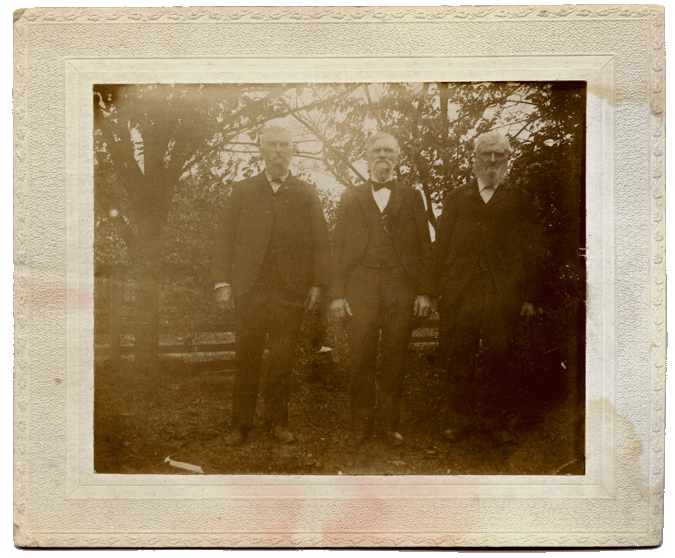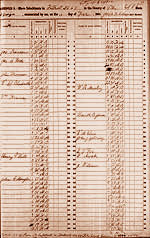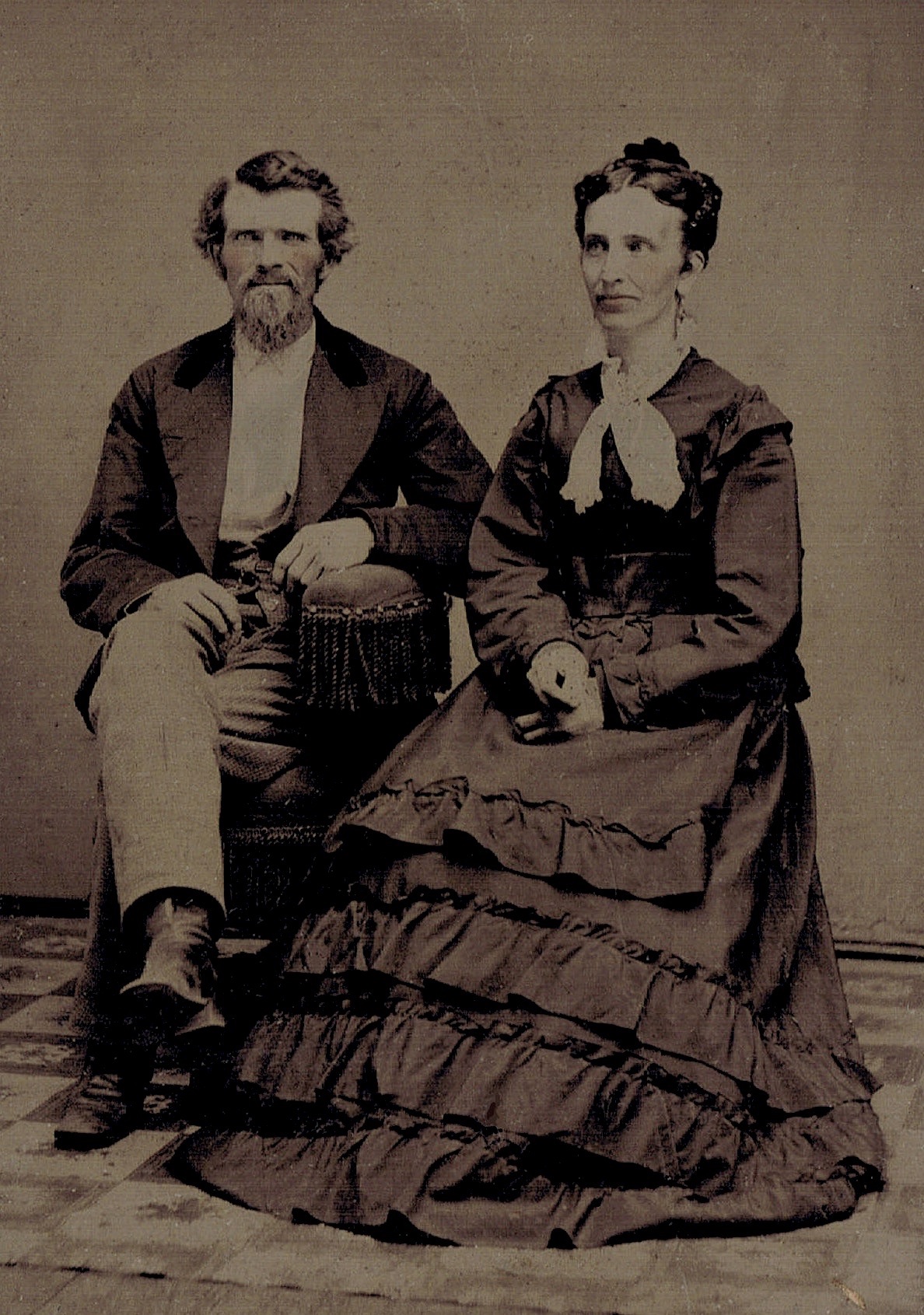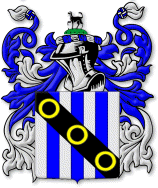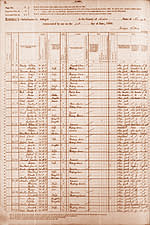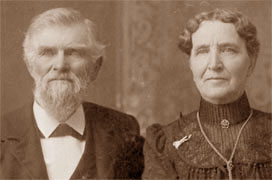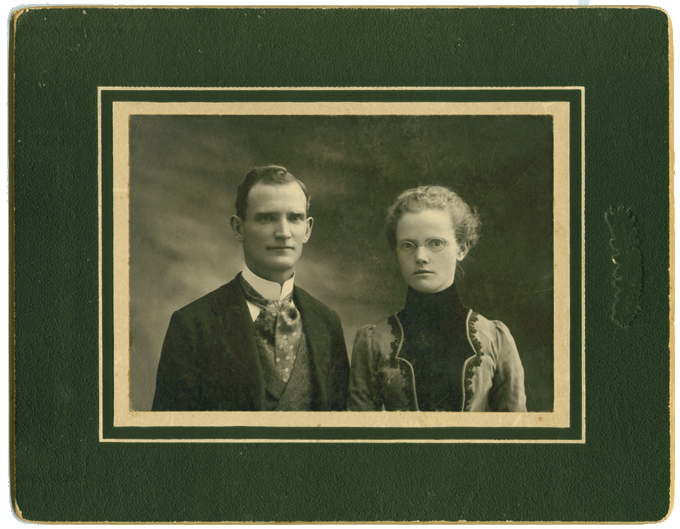 |
"A small settlement grew up, a dam was built across Belle River and a saw mill and grist mill erected ... In 1848 it was felt that a post office was needed and it was necessary to select a name. Considerable discussion arose. Various names were suggested, among others, Belleview, because of Belle River, Riley, because of John Riley, the Indian half breed, after whom the township was named, Birney, in honor of James G. Birney, the anti-slavery propagandist and candidate for the presidency of the liberty party in 1844. Finally the name of Memphis, from the Egyptian city, was suggested and adopted."
—"St. Clair County, Michigan, its history and its people," by William Lee Jenks, 1912.
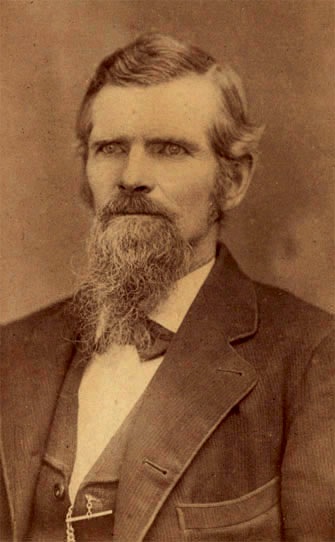 |
Michigan itself was finally established as a territory in 1805, and boasted a population of around 3,000 French fur traders living around the Detroit River under a very undemocratic centralized government, which featured three judges and a governor (Revolutionary War hero William Hull) appointed by the United States government making all of the laws. Most of the territory outside of Detroit actually belonged to the Indians, and until a treaty in 1807 the land was unavailable for claims.
Detroit was actually lost to the British for a time in the War of 1812—when the United States government forgot to notify their frontier posts in Michigan that the country was at war. So when 520 British soldiers crossed St. Mary's River on July 17, they took Fort Michilimackinac without a shot being fired, then overtook Detroit in August. But the United States won Michigan back in the Battle of the Thames in 1813 and started over fresh in the territory.
In 1818, the question of local government was put before the people, and in what has to be considered the greatest French joke of all time, they held a free election and voted NOT to vote anymore, or have a voice in their own government.
Finally, in 1824, a legislative body was established that would be appointed by the people, and the residents of Michigan finally were able to control their own destiny.
The Erie Canal opened the next year, which combined with the beginning of steam navigation on the Great Lakes, and brought a rapid increase in settlement, including a few trailblazing Hauses, mostly the descendants of William Hause, Jr,. in the early 1830s. Meanwhile, the new government immediately went to work screwing the Indians out of more land, and by 1840 the last Native American land was turned over to the United States, except for a few small, scattered reservations. (It would take 150 years before they could open up gambling casinos on those reservations and start screwing back.)
Michigan became a state in 1837, after a near-war between its militia and Ohio's over their respective boundary lines (the prize being TOLEDO, of all places).
Expansionism was the word of the day, and our line of the Hause family was moving west again—screaming that word from the mountaintops (if they could find an actual mountaintop in Michigan). But while Michigan had few mountains, it had plenty of flat land, perfect for farming, with plenty of wilderness from which to carve out a home.
|
THE LAWS OF MICHIGAN IN THE 19TH CENTURY: |
|
|
By the mid-19th Century, New York's Niagara County had become completely settled, and finding a fresh, cheap plot of New York land to raise a family on was next to impossible. Fortunately for LABAN AUGUSTUS HAUSE (b. 10 March 1831) and his brother John, the Dysinger daughters had each been willed about a hundred acres of prime farmland in Lockport by their late father—enough for a small private farm. But Laban and John had the bright idea of selling that expensive New York land, and using the money to buy more property in an area where the land was cheaper. The plan was to move west and carve out their own place from the wilderness... and the new frontier of Michigan was beckoning.
| From left to right: Brothers Augustus Hause, Jr., Laban Hause and John Hause pose together at a family reunion in the late 1800's. (From the collection of Carleton Marchant Hause, Jr.) |
So in the mid-1850s, three of Augustus' children—John, Laban, and Basheba—and several of the Dysingers headed to the new state—either taking a steamship up the Erie Canal, or by land using teams of oxen or mules, towards the untamed wilderness (read: cheap land).
They were starting over again—much like Johann Christian Hauss had done 150 years before when he sailed to this country from Europe.
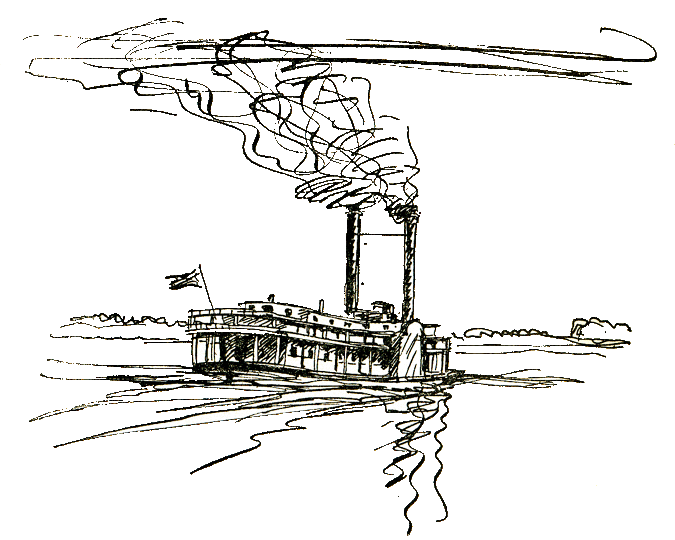
| ||||||||||||||||||||||||||||||
He and Sarah then sold 100 acres of property that Sarah had inherited from her late father in Lockport, for $500. The document was signed by Sarah's mother, Catharine, and accepted by Laban "House" and Sarah in St. Clair county, Michigan. (On the next page in the book of deeds, Catherine sold more of the Lockport land willed to her other children, including John and Eve Dysinger-Hause.)٠
The various Hause and Dysinger families then settled in, and even began to expand. St. Clair County records show that on the 13th of May, 1857, 21 year-old Basheba married Charles H. Oaks, 23, of Riley. The witnesses were "Loban" Hause & John J. Hause, also of Riley; the wedding was performed by Minister William P. Russell.
Living on the edge of the Michigan wilderness left the Hause family far away from doctors, hospitals, and the superior medical attention available back in New York (which in truth wasn't all that great, anyway). There were only ten licensed physicians in all of St. Clair County. They charged from five dollars for minor surgeries, up to a hundred dollars for major ones. There was also a fee of five to twenty-five dollars for midwifery, which Sarah needed in 1857 for the birth of a child:
CHILDREN OF LABAN AUGUSTUS HAUSE AND SARAH DYSINGER | |
|
But there were problems during the delivery of Elma. Sarah developed complications after the birth, and became sick. She lingered for two years before finally dying on March 16, 1859 (fortunately, Elma was a healthy baby).
Laban was not prepared to raise an infant daughter by himself in the wilds of Michigan. His sister, Basheba, and brother John had settled nearby and probably helped with Elma, but Laban needed a more permanent solution. Like his father Augustus, he wasn't the type to mourn his loss for long—he set about looking for a mother for Elma.
The outcome of this search can be found in the 1860 census:
|
The official enumeration day was June 1st. There were a total of thirty-three states in the Union, with Minnesota and Oregon being the latest additions. Augustus Hause still remained in New York, listed as a 55-year-old farmer, now married to 35-year-old Fannie Christopher. Augustus Jr., his last child from Jane Jones, still lived at home with him. But Laban has moved to Michigan, as had his children John, Laban and Basheba. John was Justice of the Peace in Riley from 1859-66 (but he would move back to Royalton before 1880). Laban was listed as a farmer, living next to his ex-brother-in-law Nicholas Dysinger, with $1500 of real estate and $447 in personal estate. Sarah Dysinger-Hause was dead, however, and Laban had married again, to a truly remarkable woman...
|
|
Laban and Melissa were wed in Riley Center on October 25, 1859. (Laban's previous marriage apparently never bothered the youthful, always-optimistic Melissa—in fact, Laban is today buried between both of his wives in the Memphis Cemetery.
Melissa was a school teacher (in fact she was so bright that she started teaching in Memphis at age 15), and she would change the course of our family history. She brought culture and education to the Hause family. Schooling was always important to Germanic immigrants, but not as much to farmers, which the Hause family had mainly become over the previous 150 years in America. Farmers are more concerned with being able to sell crops than being able to spell them. But after Melissa, the Hauses (at least the men) would all be college-educated (I dropped out of Long Beach State in 1984 to write the film Once Bitten after the producers threatened to can me and hire a full-time screenwriter, thus ending the streak. Sorry, Melissa).
In the early 1860's the Civil War raged throughout the country. But there was no way that Laban could go to war. He was busy trying to start his life again with a new wife, and start a new family (Alice was born in 1861 at the start of the war, and Sarah followed in 1863).
Laban had four children with Melissa, and the family prospered. In fact, period photographs show them in the stylish clothes of the day—always clean, which was rare for Michigan—and the children are quite healthy-looking and attractive (which you can't always say about frontier families).
|
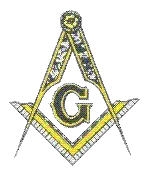
|
Laban became a Freemason,Ҡreciting his oath to the Memphis Lodge: "To the high purposes of universal Masonry, to brotherly love, relief and truth, to the upbuilding of this Lodge; the promotion of harmony among its members, to the realization of its highest ideals of character and of life; to the stretching forth of our hands to aid and support a fallen brother, and to the vindication of his character behind his back, as well as before his face, we here and now, pledge anew, our most earnest and unceasing efforts." In fact, he's wearing a Mason pin in the above photo (2nd button down).
The early Freemasons in Michigan helped create and fund the University of Michigan, and other important institutions, and the community in Memphis was eager to join in. So on January 14, 1864, the charter was accepted for Mason's Lodge No. 142 in Memphis by the Grand Lodge of Free and Accepted Masons in Michigan. Laban became an apprentice at the lodge in 1874, earned his Fellowcraft Degree, and a Master Mason Degree, all in the same year, and remained active for the next 31 years.
There are a great many rumors and myths about freemasonry: That in order to join you must drink wine out of a human skull, etc. But it's really a fraternity dedicated to improving the community through work and education, and Laban and his son, Frank, were both heavily involved in the organization during their lives, so the Hauses were an integral part of that lodge for the next 75 years.
|
In this 1870 census, 66-year-old Augustus remained in New York with Fannie and their two-year-old daughter; Meanwhile, Laban had moved to Emmet, St. Clair County, Michigan, and now had a son: three-year-old Frank Hause, the next in our line, with siblings Elma, Alice, and Sarah.
Laban decided to earn some extra money off the farm and became the Postmaster in Emmett from 1869 to 1873. The Hause family never fit in with the community there. (It was "too Catholic," according to Laban's grandson Basil—much of our family history had been lost, but our Reformist, anti-Catholic bias was apparently still being handed down.)
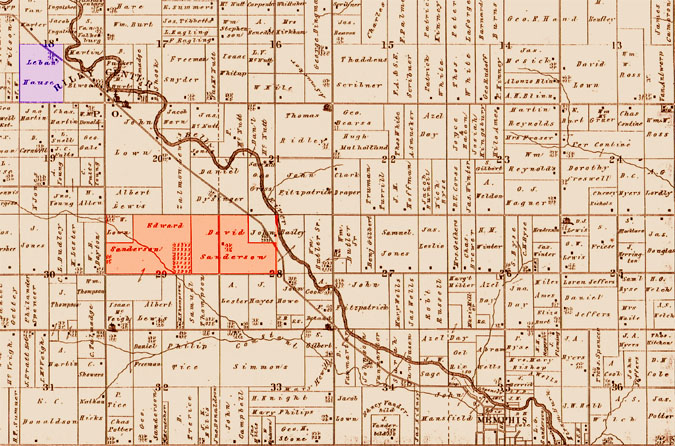 A map of Riley Center in 1876. Laban's property (#18) is in blue, while the farms of father-in-law David Sanderson and brother-in-law, Edward, are in sections 28 and 29. (Enlarge.) |
|
Laban did well for himself in this new frontier, and his fortune grew—and Michigan grew right along with it, as forests became farmland and townships became cities in the ensuing decades.
Laban's family also grew: He and Melissa had the following children, who they raised along with Elma:
CHILDREN OF LABAN HAUSE AND MELISSA SANDERSON | |
| |
| |
| |
|
| |||||||||||||||||||||||||||||||||||||||||||
Augustus Hause had passed away in 1875, but Laban, now middle-aged, was still going strong. He's no longer listing "farmer" as occupation, as he was at that point running the store in Millington Village. They also have a boarder at the house listed as a clerk, as well as children Frank and Edith.
The Hause family was prospering, but the harsh realities of life on the frontier were always present: In 1881, their daughter Sarah—named after Laban's first wife—died from Typhoid Fever after eating contaminated beans served at her wedding to a store clerk named Arthur Baker, a foster child who had been living with Oliver and Mary Gold of Millington. She wasn't considered in a dangerous condition by her doctor, L.C. Davis, but suddenly took a turn for the worse and died within a few hours. She is buried today near her father, in the Memphis Cemetery.
Needing a change after that peculiar tragedy, Laban gave up the store (they definitely weren't going to be able to sell any canned beans) and returned to Riley Center in 1882, where he built a substantial brick house with a smoke house and barn, at 13185 Belle River Road, near the Sanderson family. This property incorporated the farmland of Melissa's brother, Edward Sanderson, and would become this Hause line's home base for the next 40 years. There was a windmill in the back for power and an apple orchard for food, and Laban built a smokehouse nearby to prepare meat for the table.
In one of the more macabre anecdotes in our family history, the stone for Sarah Hause's grave was delivered to the new house, but the inscription on the face of the stone was incorrect. Laban refused to pay for it, but the carver refused to take it back. So the stone stayed in the front yard of the Hause family house, un-bought and unused, until Laban finally made it the step-stone to the front of the house.
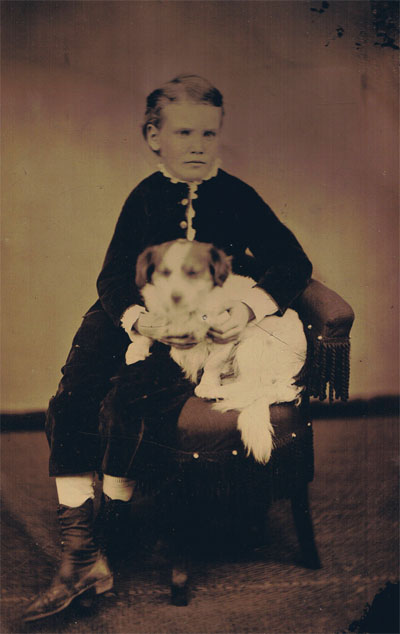 A tin-type of Frank Hause. (Courtesy of Jerry Hause.) |
Frank never really followed his father's tastes. While Laban was in Millington, Frank returned to Riley Center and worked for his uncle, Ed Sanderson (1831 - 1907). When Laban built the brick farmhouse, Frank carried bricks for his father to build the estate—but even then he refused to work with his father, and stayed with his job at Uncle Ed's. (He did, however, become very involved in the local Masons Lodge with his father. Frank signed on as a "Master Mason" on September 19, 1900.)
Frank inherited his father's intensity (compare Frank's eyes with those of Laban) and his mother's sense of style. A born salesman, Frank had a certain swagger—he would be the perfect man to lead the Hauses into the 1900's. But he couldn't have done it without the help of an amazing woman:
|
Fladella's father, Albert, was in the Union battalion that captured Jefferson Davis at the close of the Civil War. He was a blacksmith (which makes you wonder if he knew the ancestor of his new son-in-law was the great silversmith Robert Sanderson), and also worked in the Port Huron customs office. But soon they would live near the Hause family in Riley Center.
Fladella was something of a warrior herself, who fought to protect her family throughout her long life. She even teamed with Melissa to run a boarding house in Ypsilanti, so that her sons would have money and lodging for a nearby college, in order to make sure that the next generation of Hauses would have opportunities that their ancestors were denied.
Laban was elated over the engagement of his only son. Around 1888, he built a fine brick house across from his farm property for Frank and Fladella. But much to Laban's disappointment, the newlyweds instead moved into an old log cabin—actually a sheep barn—on the Raymond property, which Fladella's father had converted into a home. They immediately started a family, and produced the three sons that would carry the Hause family into the Twentieth Century.
Here are the children of Frank and Fladella Hause:
CHILDREN OF FRANK AUGUSTUS HAUSE AND DELLA RAYMOND | |
| |
| |
| |
|
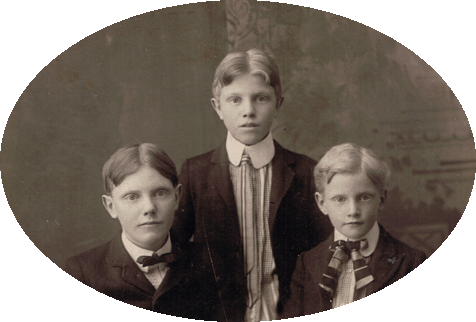
|
 A map of Memphis in 1896, showing that Laban (in blue) has moved into town. (Enlarge.) |
|
Soon farms would be replaced by factories; and beyond that there would also be airplanes, televisions, telephones, movies, organized sports, psychotherapy, organized crime, and most importantly for Michigan, the automobile. And many say the first auto was built in Memphis:
Thomas Clegg and his English-born father, John, built "the thing:" the first recorded self-propelled vehicle in Michigan (and perhaps in the country) in 1884-85 at the John Clegg & Son Machine Shop, located at 35412 Bordman at the southeast corner of Bordman Road and Cedar Street in Memphis. "The thing," driven by a single cylinder steam engine with a tubular boiler, seated four. Leather belts transferred the power to the 5'8" rear wheels. Soft coal was used for fuel. At first Clegg called the machine a "contraption" but finally settled on "the thing." It was an appropriate name, because it turned out to be "the thing" that ate Michigan! Soon the first cars in the United States were being built by men in the Great Lakes area—Henry Ford, Ransom Olds, Charles B. King and David Dunbar Buick all lived in Michigan. In 1897, Olds Motor Vehicle Company, Inc., was organized by Ransom E. Olds with capital of $50,000 (5,000 shares of stock at $10 per share). Soon after, the first Oldsmobile was produced, and became the first mass-produced car in the country. Within ten years the company would be folded with several other brands into a corporation called General Motors, which became so prosperous that in 1909 it bought Cadillac for $5.5 million.
But it was Henry Ford who soon dominated the industry. He introduced automated production and in 1908 Ford decided to focus his company's efforts on the construction of only one model—the Model T. To help lower costs and speed production, he began moving toward assembly line production.
But Clegg didn't profit from any of this: He said that after his father's death, four years after the car was build, he had "neither the time or money to continue the experiments along." In an exceedingly uncharacteristic fit of generosity and gratitude, Henry Ford reportedly offered to buy the Clegg machine shop for Greenfield Village, but the offer came too late. Clegg pulled down the building in 1936, just a short time before the offer by Ford was made. He died in May 1939 and his wife the following March.
Our line of the Hause family changed with the times as well. No longer a line of farmers, they became educators, land speculators, and entrepreneurs. "Tom, Dick and Harry" were born salesmen like Frank, but with Fladella's work ethic and iron will, and they adjusted easily to modern society. But Frank's sons never forgot the family roots as they carried our family into the modern era in...

|
TITLE PHOTO: Sunset over Memphis, Michigan, by William Biscorner.
NOTES ON THIS PAGE:
¹—One witness to Laban and Sarah's land sale agreement in Michigan was named DAVID SANDERSON, appearing on the second page, who would become very important in Laban's later life.
²—No one knows just how old freemasonry is, because the actual origins have been lost over time. Probably, it arose from the guilds of stone masons who built the castles and cathedrals of the Middle Ages. Possibly, they were influenced by the Knights Templar, a group of Christian warrior monks formed in 1118 to help protect pilgrims making trips to the Holy Land.
The society's influence is everywhere: Presidents George Washington, James Monroe, Andrew Jackson, James Polk, James Buchanan, Andrew Johnson, James Garfield, William McKinley, Theodore Roosevelt, William Taft, Warren Harding, Franklin D. Roosevelt, Harry Truman, Lyndon Johnson, Gerald Ford, Ronald Reagan and George Bush were all Masons (Bill Clinton was in a freemason youth group). Others included Winston Churchill, Napoleon Bonaparte, Ben Franklin, John Hancock, Paul Revere, Davy Crockett, Walt Disney, Samuel L. Clemens (Mark Twain), most of the Kings of England, the Rothschilds, the Rockefellers, Orville and Wilber Wright, Billy Graham, Jesse Jackson, Mormon Church heads Joseph Smith and Brigham Young, and FBI head J. Edgar Hoover.
³—The first newspaper in Memphis was the Daily Bug, established in 1877. The name of the paper was later changed to the Memphis Tribune, and again in 1882 it was changed to the Memphis Banner. It was published once a week on Fridays and was sold for $1.00 per year. Next came the Memphis Bee, founded in about 1893.
LITERARY SOURCES FOR THIS PAGE:
|
CHAPTER 1: THE DUCHY OF SOLMS, 788 - 1709 CHAPTER 2: JOHANN CHRISTIAN HAUSS, 1666 - 1725 CHAPTER 3: THE HAUSS FAMILY OF THE MOHAWK, 1711 - 1725 CHAPTER 4: JOHANN, JOHANNES AND JOHN, 1725 - 1775 CHAPTER 5: THE AMERICAN REVOLUTION, 1775 - 1783 CHAPTER 6: WILLIAM HAUSE, 1750 - 1818 CHAPTER 7: WESTERN NEW YORK, 1783 - 1855 CHAPTER 8: NIAGARA COUNTY AND THE ERIE CANAL, 1831 - 1875 CHAPTER 9: THE CIVIL WAR, 1861 - 1865 CHAPTER 10: MICHIGAN, 1855 - 1900 CHAPTER 11: MICHIGAN, 1901 - 1929 CHAPTER 12: THE GREAT DEPRESSION, 1929 - 1959 CHAPTER 13: CALIFORNIA, 1959 - 2007 CHAPTER 14: AFTERWARD, 2007 - PRESENT |
